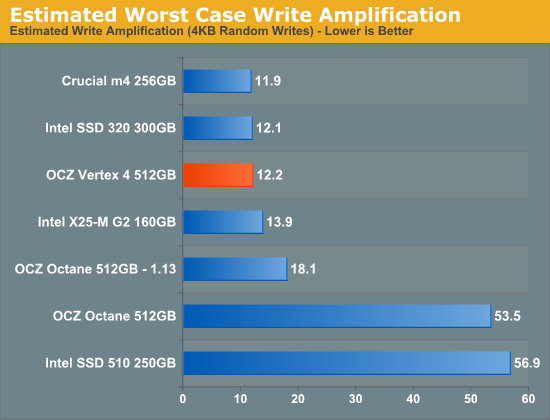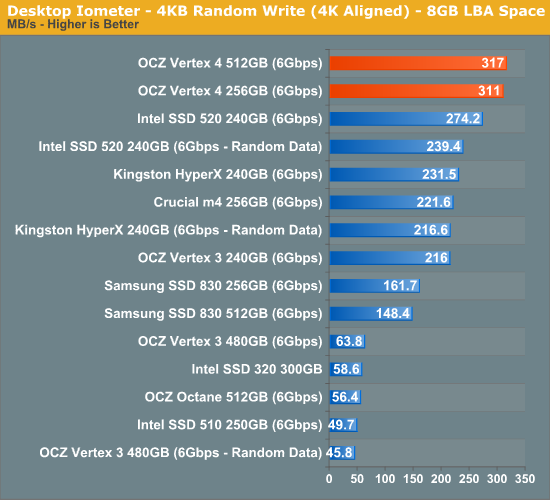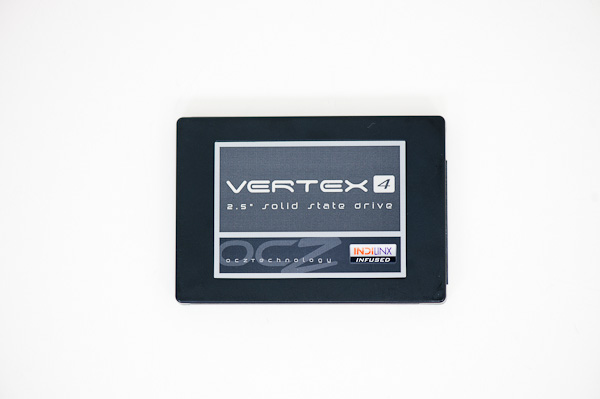OCZ Vertex 4 Review (256GB, 512GB)
by Anand Lal Shimpi on April 4, 2012 9:00 AM ESTThirteen months ago OCZ announced its intention to acquire Indilinx, the SSD controller maker that gave Intel its first taste of competition in the consumer market in 2009. Eight months later, OCZ launched its first post-acquisition SSD based on Indilinx silicon. Today, just five months after the launch of the Octane, OCZ is officially releasing the Vertex 4 – based on its Indilinx Everest 2 silicon. In less than a year, OCZ has brought to market more Indilinx powered controllers than Indilinx did in the previous three years. It's rare that you see the fruits of acquisition so quickly, but if there's anything OCZ's CEO Ryan Petersen is good at it's pushing for an aggressive schedule.
Rather than call this drive the Octane 2, OCZ went with Vertex 4, indicating its rightful place at the top of OCZ's SSD lineup. The implications run even deeper. It marks the first time in two years that a Vertex drive will ship without a SandForce controller inside. Make no mistake, while Octane was a shot across SandForce's bow, Vertex 4 means war. While OCZ continues to ship tons of SandForce controllers, the future for the company is Indilinx. The Vertex 4 is just the beginning. OCZ will continue to ship Vertex 3 in parallel, and should a future SandForce controller make competitive sense to use OCZ will definitely consider it, but the intention is to build the fastest silicon internally and use it as much as possible.
The dramatic departure in naming also embodies just how different Everest 2 is from the original Everest controller. OCZ claims there's minimal shared code between the Octane and Vertex 4 firmware, and the two drives perform very differently. Write amplification was always a concern with the Octane - it is no longer a major issue with the Vertex 4. OCZ and its Indilinx team have reduced write amplification to roughly the levels of Intel's controllers:

Indeed write performance is improved significantly as a result. A look at the spec sheet gives us the first indication of what's to come:
| OCZ SSD Comparison | ||||||
| OCZ Vertex 4 | OCZ Vertex 3 | OCZ Octane | OCZ Vertex 2 | |||
| Current NAND | 25nm IMFT MLC | 25nm IMFT MLC | 25nm IMFT MLC | 25nm IMFT MLC | ||
| Capacities | 128, 256, 512GB | 60, 90, 120, 240, 480GB | 128, 256, 512GB, 1TB | 60, 120, 240GB | ||
| Controller | Indilinx Everest 2 | SF-2281 | Indilinx Everest | SF-1221 | ||
| Max Seq Read | 535 MB/s | 550 MB/s | 480 MB/s | 285 MB/s | ||
| Max Seq Write | 475 MB/s | 500 MB/s | 330 MB/s | 275 MB/s | ||
| Max Random Read | 95K IOPS | 60K IOPS | 26K IOPS | - | ||
| Max Random Write | 85K IOPS | 85K IOPS | 35K IOPS | 50K IOPS | ||
| AES-256 Encryption | Yes | Yes | Yes | No | ||
Regardless of the nature of the data (compressible or incompressible), the Everest 2 powered Vertex 4 promises better random write performance than any other consumer SSD on the market today. And it delivers:

Random write speed is nothing short of incredible. OCZ is able to equal SandForce's write speed on highly compressible data without resorting to any sort of data compression. This is a purely algorithmic advantage. While the original Everest was a work in progress by the time OCZ acquired the company, Everest 2 is the first Indilinx project OCZ had complete control over. Apparently OCZ's CEO, Ryan Petersen had a lot of his own input built into this design.
| OCZ Vertex 4 Lineup | |||||
| 512GB | 256GB | 128GB | |||
| NAND Configuration | 16 x 32GB 25nm Intel sync NAND | 16 x 16GB 25nm Intel sync NAND | 8 x 16GB 25nm Intel sync NAND | ||
| DRAM | 2 x 512MB DDR3-800 | 2 x 512MB DDR3-800* |
2 x 512MB DDR3-800* | ||
| Controller | Indilinx Everest 2 | Indilinx Everest 2 | Indilinx Everest 2 | ||
| Max Seq Read | 535 MB/s | 535 MB/s | 535 MB/s | ||
| Max Seq Write | 475 MB/s | 380 MB/s | 200 MB/s | ||
| Max Random Read | 95K IOPS | 90K IOPS | 90K IOPS | ||
| Max Random Write | 85K IOPS | 85K IOPS | 85K IOPS | ||
| MSRP | $699 | $349 | $179 | ||
The Vertex 4 will be available in three capacities initially – 128GB, 256GB and 512GB, with a 1TB version following. Drives should be available today but in very limited quantities, and likely only 128GB capacities at the start. MSRP is fairly competitive with other 6Gbps drives on the market today:
| SSD Pricing Comparison | |||||
| 128GB | 256GB | 512GB | |||
| Crucial m4 | $154.99 | $299.99 | $549.99 | ||
| Intel SSD 520 | $184.99 | $344.99 | $799.99 | ||
| Samsung SSD 830 | $174.99 | $299.99 | $779.99 | ||
| OCZ Octane | $199.99 | $339.99 | $849.99 | ||
| OCZ Vertex 3 | $199.99 | $339.99 | $1199.99 | ||
| OCZ Vertex 4 | $179 MSRP | $349 MSRP | $699 MSRP | ||











127 Comments
View All Comments
vol7ron - Wednesday, April 4, 2012 - link
Exactly, and it's where power consumption matters even more.I'd also like to see where the OWC drives fit in.
ViviTheMage - Wednesday, April 4, 2012 - link
There are plenty of lower pwer SSD's that have similiar tasty iops, so you won't be disappointed...the falvouring is a little different, but you will still enjoy it.ckryan - Wednesday, April 4, 2012 - link
I very much expect the next generation of Marvell drives to look similar in some respects to the V4.I applaud OCZ for doing things differently, but they're probably just trying to beat the next wave of Marvell powered drives to market, not making up for SFs immediate deficiencies.
ViviTheMage - Wednesday, April 4, 2012 - link
Do you think Marvell can release a drive with as many delicious iops?Kristian Vättö - Wednesday, April 4, 2012 - link
Not Marvell, because they only make controllers ;-)Plextor M3 Pro is already providing up to 75K/69K IOPS (read/write). Marvell released a new controller a couple of weeks ago and at least according to the press release, random speeds should be substantially improved with a great firmware. How fast is still a question but I wouldn't be surprised to see figures similar to Indilinx 2.
And as a side note, Plextor M3 review should be up later today or tomorrow as well :-)
ckryan - Wednesday, April 4, 2012 - link
The M3P is fantastic. It's like the V4 without the compromise. Plus, I'd take better low QD performance any day of the week over high QD performance. The M3P is a lot more balanced.Plus, yeah, the 830 is awesome too, but it doesn't really cater to the super high 4Krw crowd. I feel like OCZ just needed to get this drive out before then next wave of similar drives hit, and will later tweak the FW to better accommodate desktop workloads.
But it does accomplish one thing -- whatever FW/FTL they strapped on that drive doesn't look like anything else at the moment. It's certainly easy to see in an ocean of charts.
I think OCZ just mainly wanted to reverse their years of SF marketing practice with the V4 -- Latency is now important. Compressible data is out. They just had to wait until they had a product that could match the paper specs of the 2281. Ironically, I'd take it over a V3 any day of the week, but the 2281 is still better with most workloads.
etamin - Wednesday, April 4, 2012 - link
Perhaps the V4 may turn out to be a more economical choice though because it is entirely developed in house.jwilliams4200 - Thursday, April 5, 2012 - link
LOL. Except for the rebadged Marvell controller and the flash memory, yeah, entirely in house.rw1986 - Friday, April 6, 2012 - link
rebadged MRVL controller?? can u elaboratejwilliams4200 - Friday, April 6, 2012 - link
Did you ever wonder why Indilinx took so long to come out with a 2nd gen controller after their first was so popular?Well, they didn't. Not really. OCZ does not want you to know that they have a relationship with Marvell, and their new controller is basically a Marvell 88SS9187. It would be hard to justify the shareholder money OCZ spent on acquiring Indilinx if the truth were known.
If you have any doubts, look at the press release from Marvell press release bullet points and compare them to the features OCZ is touting in the Vertex 4. They are identical.
http://www.marvell.com/company/news/pressDetail.do...